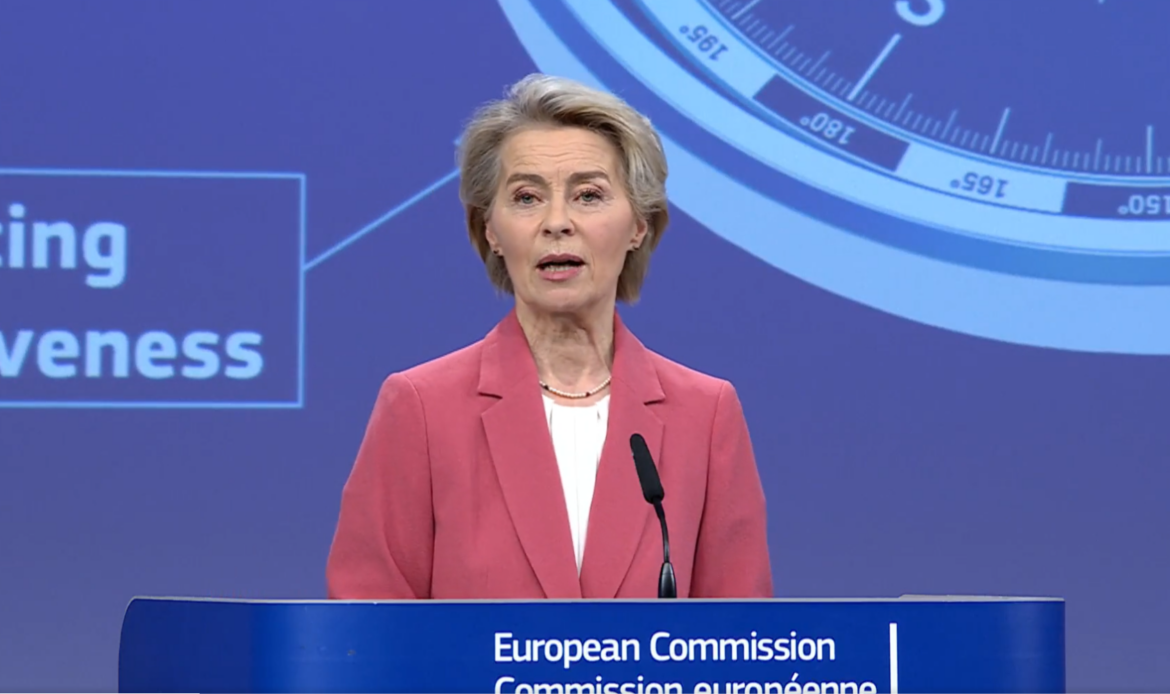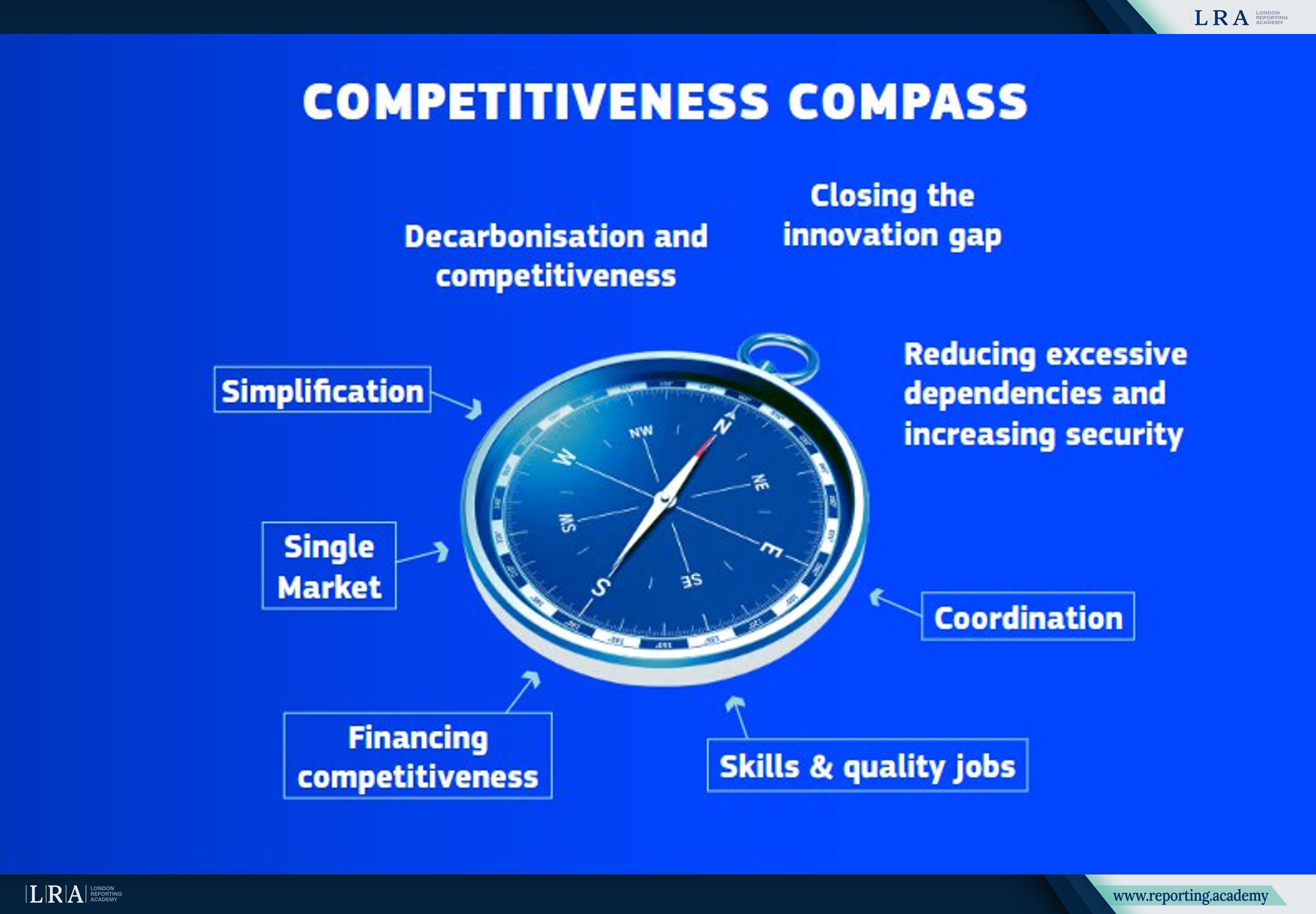EU Competitiveness Compass: Restoring Competitiveness and Ensuring Sustainable Prosperity
The European Commission has unveiled a comprehensive strategy to boost the EU’s global competitiveness. Focusing on innovation, decarbonisation, and economic independence, the initiative aims to create a favourable environment for businesses to thrive. Key actions include fostering technological advancements, reducing energy costs, and securing critical resources through strategic partnerships. This ambitious plan outlines how the EU will address current challenges and build a more resilient and sustainable economy for the future.

On January 29, 2025, the European Commission introduced the Competitiveness Compass — a strategic initiative aimed at strengthening the EU’s position in the global economy. This document outlines specific measures to address structural weaknesses, foster innovation, and enhance the resilience of European businesses.
Key Areas: Innovation, Decarbonisation, Security
The EU's strategy is built on three essential principles that are critical to enhancing its global competitiveness. These aspects are outlined in more detail below.
Closing the Innovation Gap
The EU aims to create an environment where technology companies and start-ups can thrive and compete globally. To achieve this, regulatory barriers will be removed, access to funding will be simplified, and a unified legal framework will be established.
A particular focus is placed on artificial intelligence (AI) and deep technologies. The AI Gigafactories initiative will establish industrial hubs for testing and deploying cutting-edge innovations, while the Apply AI programme will accelerate AI adoption across industries, enhancing productivity and competitiveness.
Digitalisation and Technology Integration
Europe’s productivity growth is heavily reliant on digitalisation and the adoption of advanced technologies. A significant portion of global value creation in the coming decade will be digitally enabled (70%). Although AI adoption in the EU remains relatively low (only 13% of EU businesses use AI), its integration into key sectors such as manufacturing, automotive, energy, pharmaceuticals, and financial services is critical to maintaining Europe’s competitive edge.
The Apply AI strategy is designed to increase AI adoption in strategic sectors, driving innovation in public services like healthcare and justice. Additionally, fostering EU-wide coordination through a potential “CERN for AI” and strengthening collaborations between the European Research Council and the European Innovation Council could accelerate advancements in AI for both science and industry.
Europe’s focus on closing the digital innovation gap requires substantial investments in cutting-edge digital infrastructures, including fibre networks, 6G, and cloud computing capabilities. Currently, the EU is lagging behind its 2030 Digital Decade targets, particularly in infrastructure connectivity. The Digital Networks Act will offer solutions to overcome these challenges by improving incentives for building future digital networks and reducing compliance costs.
Decarbonisation and Competitiveness
Rising energy costs pose a significant challenge to European industries, threatening their global competitiveness. The Competitiveness Compass proposes a comprehensive approach to reducing energy costs and accelerating the adoption of clean technologies.
Key measures include support for energy-intensive industries under the Net-Zero Industry Deal, tariff optimisation through the Affordable Energy Plan, and streamlined permitting for low-carbon energy projects. Investment in hydrogen infrastructure and updated energy efficiency standards will help businesses reduce costs while complying with new environmental regulations.
Reducing Dependencies and Strengthening Economic Security
To enhance economic resilience, the EU aims to reduce its reliance on imports of critical resources. A core instrument in this effort is the establishment of strategic trade partnerships that will secure access to raw materials, technologies, and clean energy. Additionally, the revision of public procurement rules will favour European producers in key sectors such as energy, technology, and healthcare, reinforcing the EU’s economic independence.
Five Pillars of Competitiveness
The foundation of the Competitiveness Compass is built on five pillars, which focus on long-term strategies for fostering growth, enhancing innovation, and strengthening Europe’s global position. They are designed to address specific economic challenges while strengthening the EU’s internal capacity for innovation and sustainable development.
Regulatory Simplification
Regulatory simplification focuses on reducing bureaucratic barriers that can inhibit business growth and innovation. The European Commission is committed to creating a more business-friendly environment by cutting down on unnecessary regulations and streamlining existing ones. This will particularly benefit small and medium-sized enterprises (SMEs) and start-ups, which often struggle with complex, costly, and time-consuming regulatory procedures.
By establishing a unified legal framework, businesses will face fewer hurdles when expanding and innovating. This pillar will also focus on the harmonisation of regulations across the EU, ensuring that businesses can operate seamlessly within the Single Market without facing different legal standards in each member state.
Strengthening the Single Market
The Single Market is central to the EU’s economic success, but barriers to entry still exist for many businesses, particularly in emerging and high-growth sectors. Strengthening the Single Market involves improving its functionality and ensuring that it operates more effectively and equitably. By removing the barriers to cross-border trade, businesses will have greater access to a broader consumer base, enabling them to grow and expand more easily.
Efforts will also be made to ensure that key sectors such as digital services, green technologies, and manufacturing can function more efficiently across borders. This pillar will also focus on improving market access for SMEs, making it easier for them to participate in larger-scale EU-wide projects and benefit from the broader economic opportunities available.

Source: EU’s Factsheet - Competitiveness Compass
Financing and Investment
Access to finance is critical for businesses seeking to innovate and expand, especially in the face of global competition. This pillar aims to improve the availability of funding for businesses, particularly those involved in cutting-edge industries such as AI, green technologies, and digitalisation. Through a combination of public and private financing, the EU will provide businesses with the capital they need to innovate and grow.
New investment instruments will be introduced to encourage private investment, particularly in strategic sectors. This pillar will also focus on making EU funds more accessible and ensuring that there are more avenues for venture capital, especially for start-ups and SMEs.
Skills Development and Workforce Adaptation
The future competitiveness of Europe relies not only on technological advances but also on having a highly skilled workforce capable of adapting to new challenges and innovations. This pillar focuses on developing the skills needed for tomorrow’s economy, particularly in the digital and green sectors.
Education and training systems will be overhauled to ensure that workers can acquire the skills required in emerging industries. Emphasis will also be placed on lifelong learning and reskilling for workers in sectors undergoing digital transformation or automation. By focusing on skills development, Europe will create a more adaptable and resilient workforce, capable of supporting long-term innovation and economic growth.
Economic Policy Coordination
Economic policy coordination is essential for ensuring that the actions of EU member states are aligned with the overall goals of the Competitiveness Compass. This pillar focuses on improving coordination between member states to ensure that national economic policies support EU-wide competitiveness objectives. It will foster better collaboration between member states on issues such as innovation, infrastructure development, and economic resilience.
This pillar will also promote best practices in economic policy, ensuring that all member states are contributing to a competitive and sustainable EU economy. Through improved coordination, the EU will be able to react more effectively to economic challenges and opportunities, ensuring that its internal market remains robust and competitive on the global stage.
Conclusions
The Competitiveness Compass is more than just a policy framework — it’s a long-term strategy for transforming the EU economy. By reducing bureaucracy, improving access to finance, fostering innovation, and aligning economic policies across member states, the Compass aims to place the EU at the forefront of global competitiveness and sustainable growth.
The implementation of the Competitiveness Compass will enable businesses to adapt to evolving market conditions, leveraging opportunities in digitalisation, sustainability, and innovation. In the long run, Europe will be positioned as a global leader in innovation-driven and sustainable growth.



